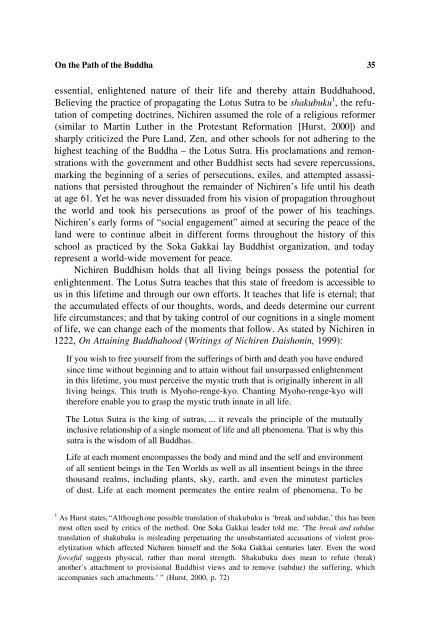Psychology & Buddhism.pdf
Psychology & Buddhism.pdf
Psychology & Buddhism.pdf
You also want an ePaper? Increase the reach of your titles
YUMPU automatically turns print PDFs into web optimized ePapers that Google loves.
On the Path of the Buddha 35<br />
essential, enlightened nature of their life and thereby attain Buddhahood,<br />
Believing the practice of propagating the Lotus Sutra to be shakubuku 1 , the refutation<br />
of competing doctrines, Nichiren assumed the role of a religious reformer<br />
(similar to Martin Luther in the Protestant Reformation [Hurst, 2000]) and<br />
sharply criticized the Pure Land, Zen, and other schools for not adhering to the<br />
highest teaching of the Buddha – the Lotus Sutra. His proclamations and remonstrations<br />
with the government and other Buddhist sects had severe repercussions,<br />
marking the beginning of a series of persecutions, exiles, and attempted assassinations<br />
that persisted throughout the remainder of Nichiren’s life until his death<br />
at age 61. Yet he was never dissuaded from his vision of propagation throughout<br />
the world and took his persecutions as proof of the power of his teachings.<br />
Nichiren’s early forms of “social engagement” aimed at securing the peace of the<br />
land were to continue albeit in different forms throughout the history of this<br />
school as practiced by the Soka Gakkai lay Buddhist organization, and today<br />
represent a world-wide movement for peace.<br />
Nichiren <strong>Buddhism</strong> holds that all living beings possess the potential for<br />
enlightenment. The Lotus Sutra teaches that this state of freedom is accessible to<br />
us in this lifetime and through our own efforts. It teaches that life is eternal; that<br />
the accumulated effects of our thoughts, words, and deeds determine our current<br />
life circumstances; and that by taking control of our cognitions in a single moment<br />
of life, we can change each of the moments that follow. As stated by Nichiren in<br />
1222, On Attaining Buddhahood (Writings of Nichiren Daishonin, 1999):<br />
If you wish to free yourself from the sufferings of birth and death you have endured<br />
since time without beginning and to attain without fail unsurpassed enlightenment<br />
in this lifetime, you must perceive the mystic truth that is originally inherent in all<br />
living beings. This truth is Myoho-renge-kyo. Chanting Myoho-renge-kyo will<br />
therefore enable you to grasp the mystic truth innate in all life.<br />
The Lotus Sutra is the king of sutras, ... it reveals the principle of the mutually<br />
inclusive relationship of a single moment of life and all phenomena. That is why this<br />
sutra is the wisdom of all Buddhas.<br />
Life at each moment encompasses the body and mind and the self and environment<br />
of all sentient beings in the Ten Worlds as well as all insentient beings in the three<br />
thousand realms, including plants, sky, earth, and even the minutest particles<br />
of dust. Life at each moment permeates the entire realm of phenomena. To be<br />
1 As Hurst states, “Although one possible translation of shakubuku is ‘break and subdue,’ this has been<br />
most often used by critics of the method. One Soka Gakkai leader told me, ‘The break and subdue<br />
translation of shakubuku is misleading perpetuating the unsubstantiated accusations of violent proselytization<br />
which affected Nichiren himself and the Soka Gakkai centuries later. Even the word<br />
forceful suggests physical, rather than moral strength. Shakubuku does mean to refute (break)<br />
another’s attachment to provisional Buddhist views and to remove (subdue) the suffering, which<br />
accompanies such attachments.’ ” (Hurst, 2000, p. 72)











